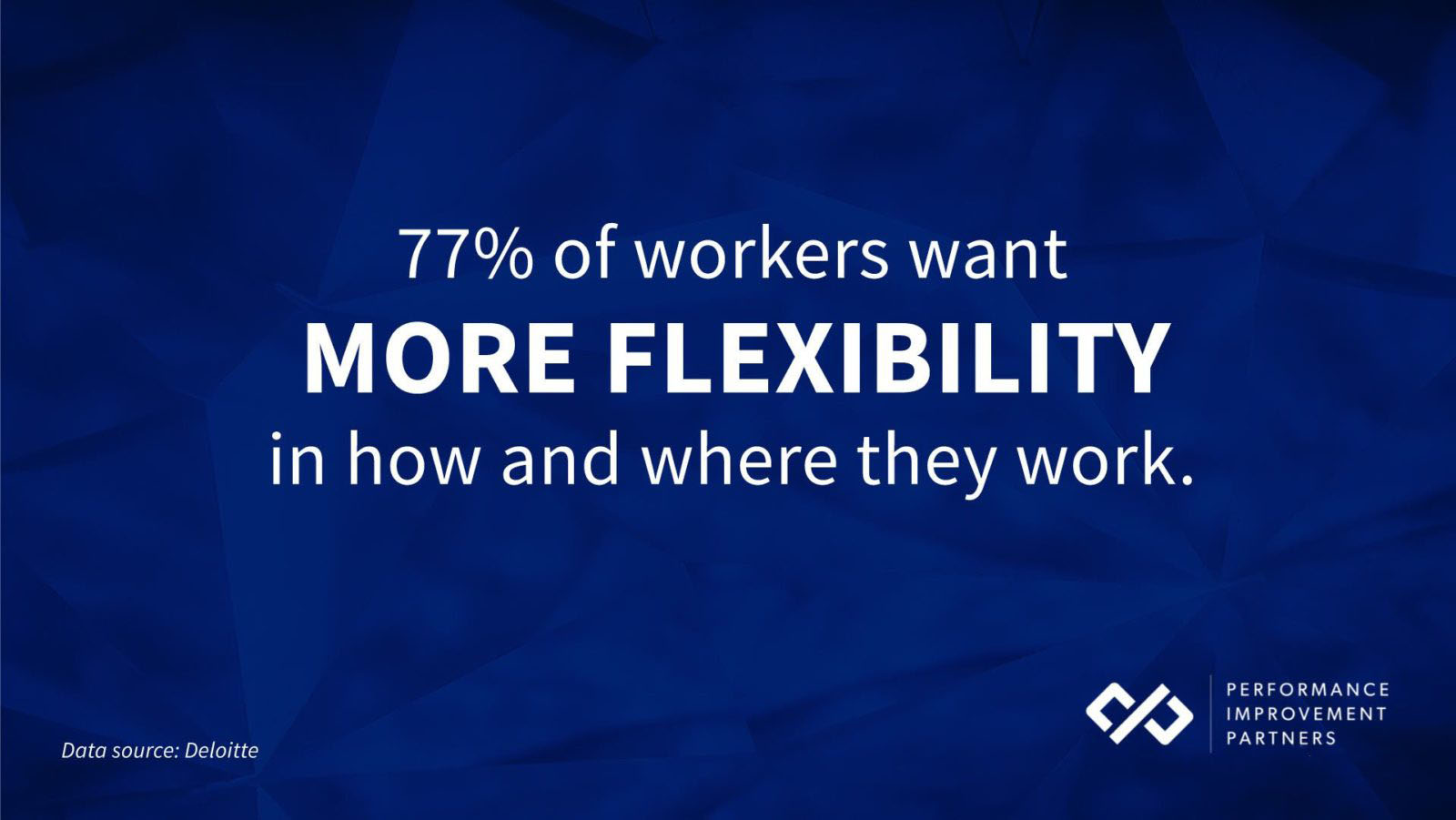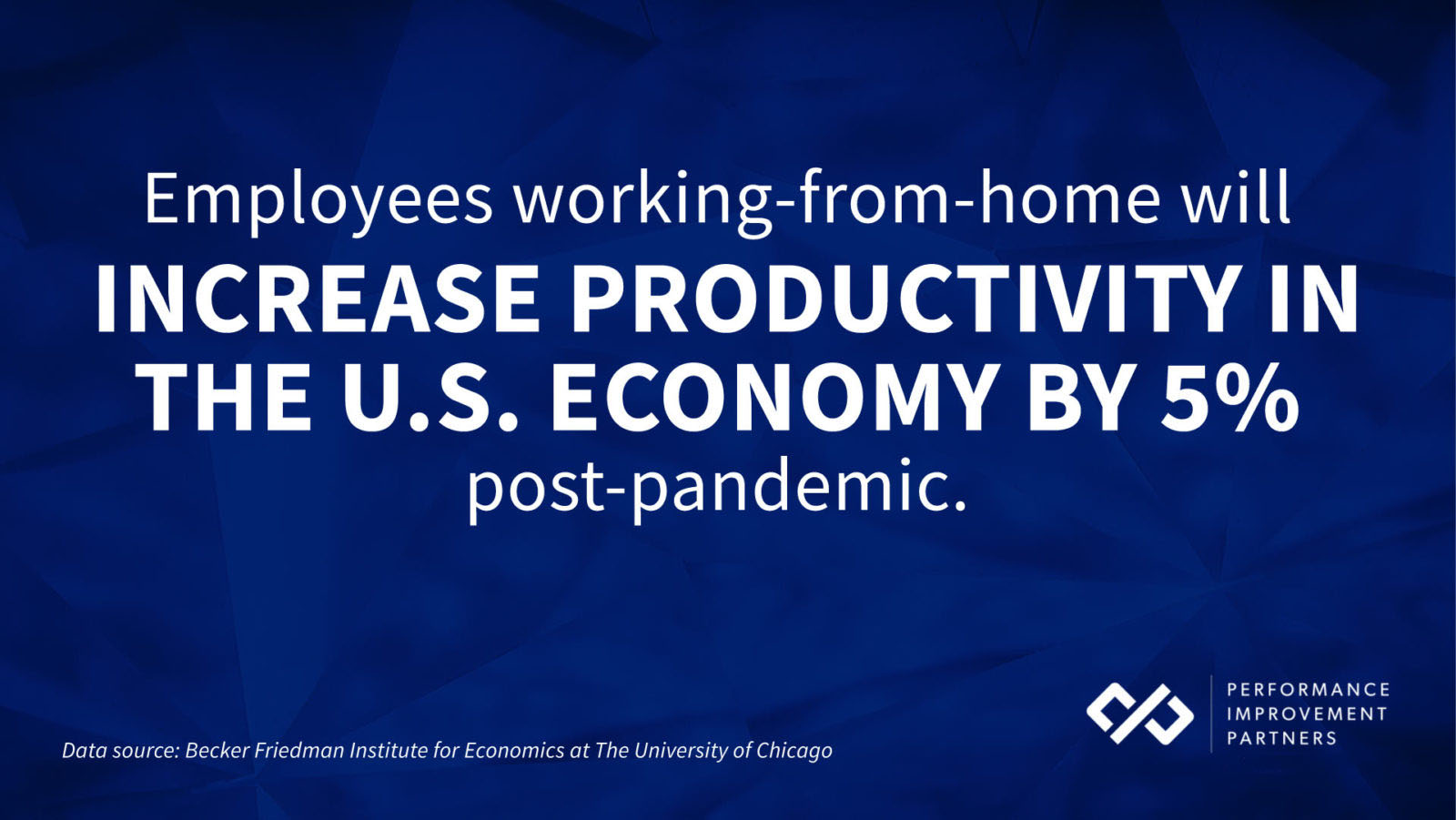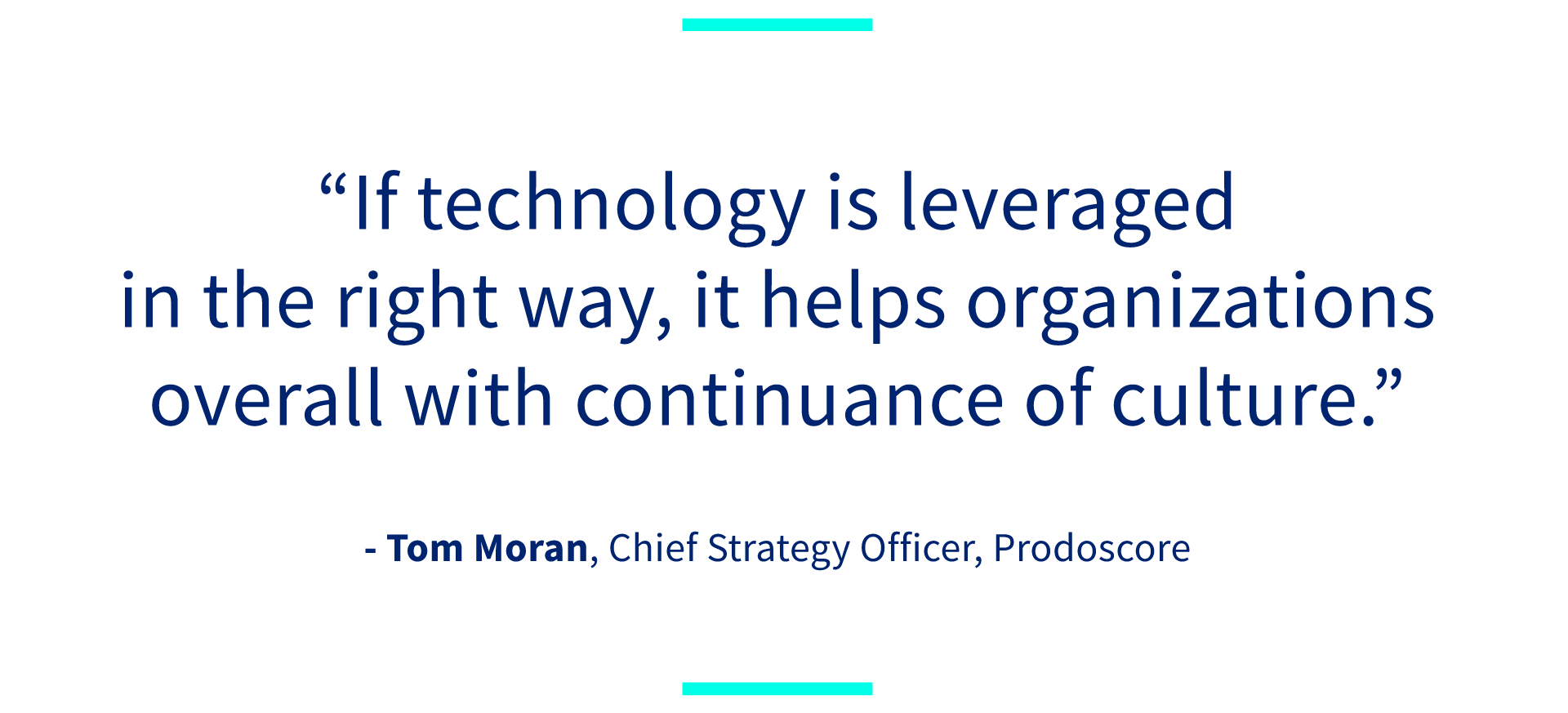While the future of work had encompassed remote and hybrid work models pre-pandemic, the shift to these working models is here to stay.
According to Accenture, “Responsible leaders must move beyond physical location to shape the future of work by giving people resources tailored to their needs.”
In fact, with 63% of high-growth companies having already implemented a “productivity anywhere” workforce model, the time to create policies that drive a competitive advantage is now.
To help business executives maximize value creation opportunities found in the new hybrid workforce, this article will cover:
- The definition of the new “hybrid workforce”
- The importance of a hybrid workforce as employees return-to-work
- The value-added benefits of a hybrid workforce model
- The role of technology in creating, supporting, and sustaining hybrid workplace
- Mitigating the cybersecurity risks of remote employees
- Considerations when implementing hybrid workforce policies
The New Hybrid Workforce: What it Is and Why It Matters as Employees Return to Work
The new hybrid workforce is defined as a blended model where employees work both remotely and in a central office location.
A hybrid workforce can be implemented by one – or both – of the following methods:
-
- The same group of employees work a combined number of hours both in the office and at a remote location. For example, many return-to-work plans involve employees working 2-to-3 days at the office, while spending the remaining business days working from home or another location of their choosing.
- Some employees work in the office while another group works remotely.
Thanks to this digitally empowered workforce, according to Deloitte, “flexible working arrangements are just the tip of the iceberg.”
“Flexible working arrangements are just the tip of the iceberg.”
-Deloitte
Deloitte’s report, “Re-architecting Work Models | Four Future Worlds of Work,” shares “The practices and philosophy surrounding how work is done is shifting…Now is the time to re- architecture work, to provide richness of choice, flexibility and autonomy – it’s time to focus on humanizing work.”
The Importance of a Hybrid Workforce as Employees Return to Work
According to Deloitte’s recent report, 77% of workers want more flexibility in how and where they work.
Alternatively, as cited by the LaSalle Network’s Office Re-Entry Index, 70% of CEOs, human resources, and finance leaders plan to have employees back in the office by Labor Day.
Some leaders in financial industry appear particularly eager to return to “business as usual” with employees in the office.
In regards to remote work, David Solomon, Chairman and CEO of Goldman Sachs, stated: “It’s not a new normal. It’s an aberration that we’re going to correct as soon as possible.”
While it has been announced that thousands of HSBC and JP Morgan staff will regularly work from home, Barclays PLC CEO Jes Staley shared similar fears of remote work maintaining sustainability.
Despite some leadership eager to pivot away from remote work, studies continue to show that employees remain strong in their desire for an improved work-life balance and the flexibility that is found in remote work.
A Harvard Business School study, surveying over 1,500 professionals who worked remotely during Covid-19, revealed that 88% of employees don’t want to go back to the office full time, with 61% wanting to work 2-3 days per week from home, and 27% hoping to work remotely full-time.
88% of employees want to work at least 2-3 days per week from home, with 27% of them hoping for full-time remote work.
-Harvard Business School
Companies who resist enacting a hybrid work policy risk missing out on the benefits that can drive significant business value.
According to Accenture’s Future of Work Survey 2021, 69% of negative or no-growth companies are still focused on where people are going to physically work.
The Value-Adding Benefits of a Hybrid Workforce Model
The benefits of a hybrid workforce – particularly when fueled by technology – lead to significant value creation opportunities.
Not only are 69% of digitally fluent companies considered a great place to work by employees, but they are also 2.7 times more likely to have experienced high revenue growth (over 20%).
However, in order to succeed, today’s hybrid workforce model must be backed by leadership.
According to Gartner, 78% of HR leaders have identified leadership mindsets as a greater challenge than their skill sets in creating a successful hybrid workforce model, stating, “The radical flexibility inherent in hybrid workforce models delivers a host of good outcomes—but only if your leadership has the mindset to champion hybrid work.”
“The radical flexibility inherent in hybrid workforce models delivers a host of good outcomes— but only if your leadership has the mindset to champion hybrid work.”
– Jackie Wiles, Gartner
Leaders looking to familiarize themselves with the positive impacts of the new hybrid workforce should consider the following benefits.
1. Increased Productivity and Employee Efficiency
Studies have shown employee productivity increases when given the ability to work remote.
In fact, a recent University of Chicago study forecasts that employees working-from-home will lift productivity in the U.S. economy by 5% in a post-pandemic world.
The technology that powers the new hybrid workforce plays a key part in this productivity gain.
According to Bloomberg, “the findings suggest the rapid adoption of new technology amid the pandemic will offer lasting economic gains, helping to boost sluggish productivity that has long weighed on global growth.”
“The rapid adoption of new technology amid the pandemic will offer lasting economic gains, helping to boost sluggish productivity that has long weighed on global growth.”
-Bloomberg
2. Improved Employee Satisfaction
With a new hybrid workforce model, you can create a new employee culture—one that embraces flexibility and balance.
Increased flexibility, less time and money spent commuting, and more time with loved ones are all remote work benefits employees are reluctant to give up.
Implementing a return-to-work plan that requires full-time office hours ignores the holistic view of employee satisfaction – which has a direct impact on employee output.
According to Sasha Tuzel, Director, Advisory, at Gartner, “More employees go above and beyond at work when organizations give them a choice over where, when and how much they work.”
Companies with happy employees outperform the competition by 20%. Alternatively, 36% of employees are willing to quit simply because they are unhappy with their job — and each resignation can cost up to one-third of an employee’s annual salary
The hybrid model allows the remote work benefits employees crave, while still fostering in-person relationships. As shared by Bisack, “It’s good to be around people—nothing replaces face-to-face relationship time. The ability to be with others stirs up ideas and creates great relationships.”
It’s good to be around people. The ability to be with others stirs up ideas and creates great relationships.
– John Bisack, Founder, Performance Improvement Possible
The flexibility in a hybrid model provides employees with the ability to work where they are comfortable, while developing renewed trust for an employer that offers a work model tailored to their lifestyle.
3. Lower Costs
Some of the ways in which a hybrid model can help lower costs include reduced overhead expenses, such as rent, telephone bills, and utilities.
Less people in the office results in smaller office spaces and the potential to negotiate short-term leases. Office perks such as free breakfast, coffee, and beverages can be reduced significantly as fewer employees work onsite. Removing spend on employee subsidized parking is another cost-savings advantage.
Less spend on physical office items – be it desks, décor, or hardware – can also lead to increased cash flow, as well as reduced spend on office supplies as simple as paper, pens, and boxes of tissues.
Thanks to the technology that fuels the hybrid working model, the increased use of video conferencing tools leads to substantial savings from reduced business travel expenses.
4. Sourcing Premium Talent From Remote Workers
A hybrid workforce backed by technology means employers can source premium talent – regardless of where they live.
According to a Harvard Business Review article by Eric Garton and Michael Mankins, Partners at Bain Capital, “Exceptional talent ― people with the ability to bring creativity and ingenuity to their work ― is a scarce and valuable resource.”
Thanks to technology, numerous jobs can be done effectively from any city in the country – if not the world.
And, as further explained by Garton and Mankins, “Physical proximity to work is no longer a primary factor in determining the pool of available labor for most companies…the best companies are capitalizing on new and different sources of talent to build the capabilities they will need to win in the future.”
Technology’s Role in Creating a Connected Hybrid Culture
Regardless of work modes, technology has increased the ability to share documents, chat in real time, and connect via video conferencing when doing business outside of the four walls of an office.
With a push for hybrid working, these technology tools, and others, are even more important as companies return to work—no matter the model.
The year 2020 taught business leaders that disruption can happen rapidly and the need to forecast and prepare for challenges in advance is no longer a “nice to have”. Businesses now must have the right technology in place – both in-office and in remote working environment — to ensure operations are maintained for inevitable, continued disruption.
That said, trends in IT spending still indicate that a large focus of increased spend will be on enterprise software and devices. One could make the case that because companies are embracing a return-to-work model that includes a hybrid workplace, larger investments in these areas are priorities.
Technology spend remains a priority thanks to the positive impact of a digitally mature workforce.
For example, according to Harvard Business Review, technology has enabled companies who, pre-pandemic, were already effective in managing time, talent, and energy, have seen up to 8% increased productivity thanks to technology enabling additional work time and access to new star talent.
“Remote work has also enabled an organization’s most skilled workers to engage virtually in a broader range of initiatives and teams than they could physically — multiplying the influence these individuals have on performance.”
-Eric Garton and Michael Mankins, via Harvard Business Review
In addition, leaders who fear a hybrid workforce negatively impacting company culture can use technology to ease their anxiety. As explained by Tom Moran, Chief Strategy Officer of Prodoscore, “Culture isn’t esoteric. It’s not a physical space. It’s how employees engage and come together in a real way for common objective.”
A digitally mature company will ensure the new-normal hybrid workforce maintains maximum productivity. As Moran goes onto explain, “If technology is leveraged in the right way, it helps organizations overall with continuance of culture.”
Examples of Technology Needed to Support an Effective Hybrid Workforce
Effective communication tools are an essential part of the new hybrid workforce. The sample list of tools below should be part of unified communications (UC) which consolidates everything from phone systems to file sharing, video conferencing, and real-time messaging into a central platform.
These tools can help employees be more productive by designating certain platforms and channels for specific types of communication (i.e., emergencies vs. 1:1 meetings vs. daily chats). An investment in the right hardware and software tools optimizes workflow, communications, efficiency, and ultimately enables better decisions for the long term.
1. Video Conferencing Tools
Companies pivoted quickly to adapt an array of video conferencing, webinar, and other video tools at the onset of COVID-19.
Now, platforms like Zoom, Cisco, and Microsoft Teams are making video digital transformations of their own by using artificial intelligence to automate tasks, recognize participants’ gestures and even give groups of people in the same conference room the ability to appear in separate windows for those working from home to see.
2. Project Management Tools
Real-time access to tasks and projects is key when employees work from various locations.
Choose a project management system whereby all employees are keenly aware of what is expected of them—deliverables, due dates and priority tasks—and can track the progress of such events whether in the office or remote.
3. Communication and Collaboration Software
The ability to communicate through the latest communication tools, such as business instant messaging ensures employees don’t miss the 1:1 communication provided by an in-office setting.
Additional benefits of these tools include an increased sense of belonging, an increased ability to stay focused and avoid distractions, and added privacy when sensitive conversations can’t be overheard in the office.
Leadership may fear losing company culture when employees aren’t in the office, but, in fact, 51% of Slack users – the highest rated business instant messaging software, say working from home improved their sense of belonging.
4. Hardware that Maximizes Productivity
Think through the logistics of employees working in the office some days and at home other days.
What will they need in terms of computers, monitors, keywords, desks, docking stations, access to internal software, etc.? Will you provide a stipend for in-home office set-ups? Will there be laptops that remote employees can check out (as you might when employees traveled)?
A hybrid workforce offers the benefits of increased productivity – but only when employees are provided with the right tools.
Speaking about the rapid transition to remote work when the pandemic hit, Gartner Analyst Suzanne Adnams shares, “Leaders across the board were shocked and amazed how quickly all their workers made the transition once they had the equipment — and by how productive everyone has been.”
“Leaders across the board were shocked and amazed how quickly all their workers made the transition once they had the equipment — and by how productive everyone has been.”
-Suzanne Adnams, Gartner Analyst
Mitigating Hybrid Workforce Cybersecurity Risks
When implementing the new hybrid workforce, it’s imperative to minimize cybersecurity implications.
Employees should not use personal computers for remote work. Instead, invest in hardware that your IT team has control over; this is an integral part in mitigating work-from-home cybersecurity risks.
Prevention is cheaper than incident remediation and though the ease of working remotely can make some aspects of the job easier, ensuring remote workers abide by security policies on and offsite is critical.
Ninety percent of data breaches result in human error—when setting hybrid work models, provide employees with tools and education to safeguard your organization.
Data breaches disrupt every industry and can cost millions to rectify. In fact, Microsoft (and companies using Microsoft Exchange Server for email) was in the hot seat earlier this year during the 2021 Microsoft Data Breach in which cybercriminals used emails to hack in—this affected small, mid, and large-sized companies.
No organization is foolproof.
Be proactive when establishing work-from-home or hybrid work models by setting solid processes, software, and back-end procedures to safeguard your company and your employees.
It’s common for hackers to target your employees, not just their machines. Alleviate hybrid workforce cybersecurity risks by downloading the 2021 Private Equity Guide to Cybersecurity.
Considerations When Implementing a Hybrid Workforce Policy
Your hybrid work policy will need to encompass a mix of input from HR, IT, and other department leaders. The type of hybrid model your company deploys will influence policy. For instance, addressing areas of work burnout—email expectations, workday start and end times, specific days of the week where meetings should be avoided—those are all valid areas to solidify with employees who have remote work hours.
Bisack’s advice to companies navigating a new hybrid workforce: “Be very open and think from the employee perspectives—they are looking to you to help create a positive quality of life experience. Set expectations with your employees that you value hard work; it needs to be win-win.”
Whatever your policy is, communicate it clearly and often. In fact, even high-level communication is better than no communication. Ask for feedback and input from employees making the process discussion-based versus dictating the rules. According to McKinsey & Company, “Employees who feel included in more detailed communication are nearly 5 times more likely to report increased productivity.”
The New Hybrid Workforce: Outcomes Backed by Technology
At the end of the day, investing in the right technology tools, implementing effective return-to-work policies, and getting feedback from employees along the way can aid in a smooth return to work transition.
No two organizations will have the same hybrid workforce model needs nor will policies change overnight. With the right tools and resources for your organization, you can provide flexibility to the employee experience while putting a positive spin on the disruption that the business may still be feeling from COVID-19.
Work with Performance Improvement Partners to build the right technology toolkit for a new hybrid workforce that maximizes potential and outsizes outcomes.






